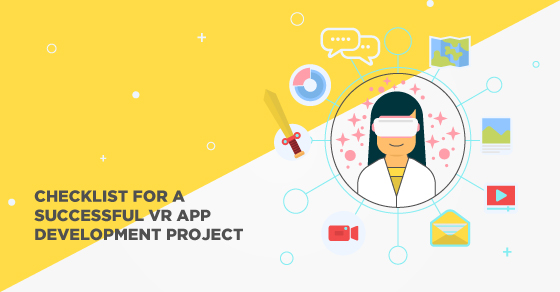"Latest Addition To Our Hybrid Mobile App Family - Be Bold Share Jesus"
"Challenges In Enterprise Mobile App Development"

As sky's the limit for VR technology, VR may seem like another industry buzzword. Now everyone has a keen eye on how VR is about to go mainstream and create a fully immersive virtual world for businesses. The applications of VR technology are worth exploring for game-changing results on different business verticals. Yet, user interest still remains less and the cost for VR gear appear to be beyond reach for most users.
Here we take a look at the checklist for a successful VR app development project:
Before you rush into shaking your head in denial, give it another thought.
VR immersive and explorative experience to the users than making linear, commercial-like stories. With VR you can grab 100% of the user’s attention and can pitch your brand message precisely.
Before starting on the project, it will be crucial to making a choice about the platform. Google Cardboard or Figment VR is the best platform that is appreciably more affordable than of other VR gears.
Cardboard is the platform if you are working out to open a mass-market product, tailored towards your users.Additionally, Google has already created guidelines, tools, and SDKs for developing VR apps for cardboards.
UI/UX designs are a deciding factor for your VR s apps and that is the main challenge in VR app development.
Because all the journey will completely rely on the way it looks and interfaces with the users. It requires a careful approaching in designing to achieve a perfect VR app, hence frame a set of prototypes and test your expectation considerably with a targeted audience.
In two ways you can create immersive content for your app, one is the shoot and modify 360-degree videos and another one is by creating 3D animations or constructions.
For creating 360-degree videos you’ll need a spherical camera to take high-quality footage. Then you will need to edit the footage and combine the video into an experience. Now you need to code the video into the end product. VideoStitch is the best VR editing tools right now.
360-degree videos are suitable for recording real-time video contents of events into VR.
With 360-degrees videos are the users are not an active participant constantly remains in the same place as a passive viewer while enjoying the experience. 3D animations allow creating a more compelling experience and let users actually move around the virtual reality where they could never physically be.
For an accurate project cost estimation, with VR things are a bit more tangled but you’ll have three distinct areas of cost estimation:
The costs of capturing 360-degree videos, creating 3d animations or obtaining realistic 3d scans differ significantly. You’ll have to decide whether you want to buy the camera and take the videos yourself or hire professionals to do that for you.
This will depend on content creation method and the platform you choose to work on. The cardboard VR app will be the cost effective option in this case.
Again, these will be decided depending on the project scale.
Once you are done with these stages, app testing will come up as the next important process. By the time it gets done, you will end up creating a unique VR app capable of ensuring optimum satisfaction for users.